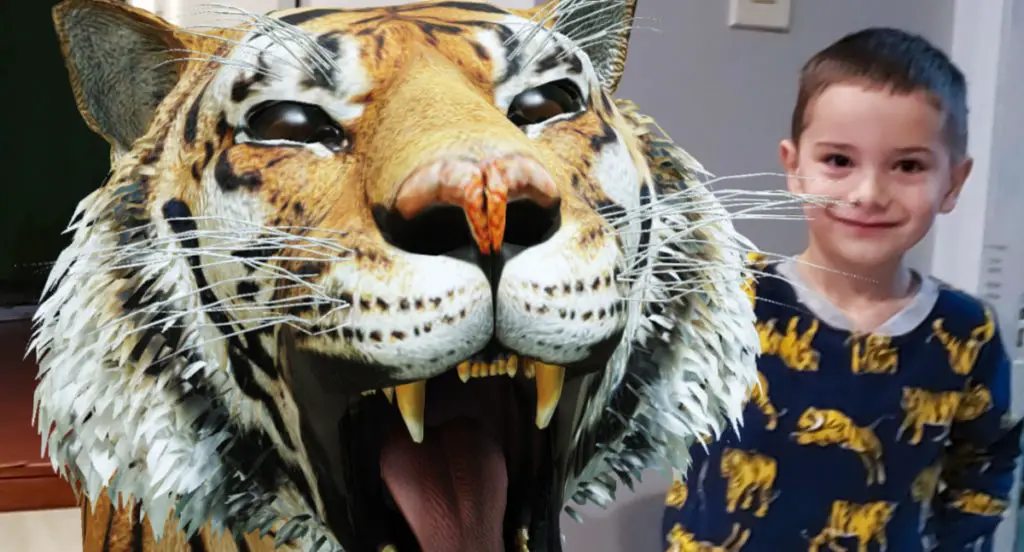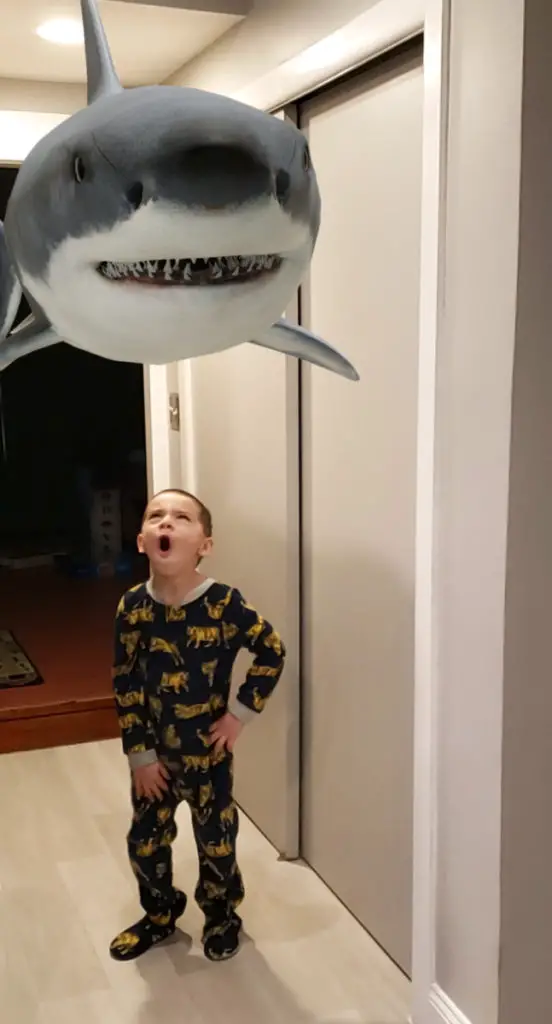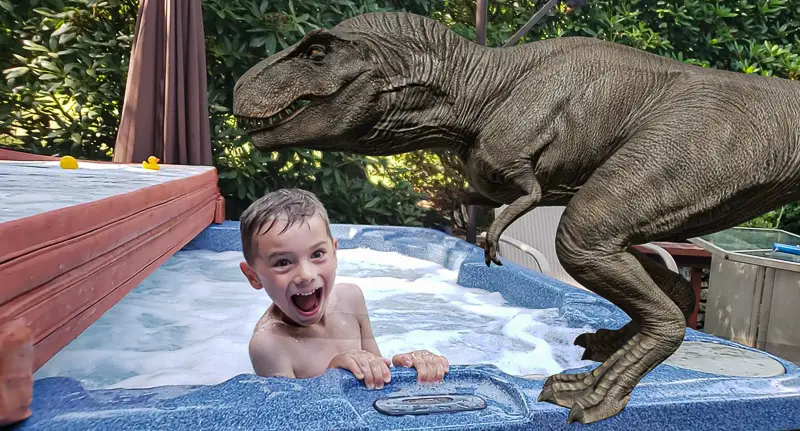Augmented Reality is a buzzword that is popping up more and more. So, what’s the buzz around Augmented Reality? What is this emerging technology, and what does it do? Does Augmented Reality live up to the hype?
Augmented Reality is making an impact on education, healthcare, industry, and entertainment. Let’s look at examples of Augmented Reality, real world applications, and how Augmented Reality is changing STEM education and industries. We’ll share how you can experience Augmented Reality right now. Let’s explore!
What is Augmented Reality
First, let’s mention what Augmented reality isn’t: Virtual Reality and Augmented Reality are often confused or used interchangeably. While they have similarities, they do vastly different things. Virtual Reality replaces your perceived environment with a fabricated environment.
Augmented Reality adds additional information to your view of the real world in real time. Sometimes this is purely informational, such as finding reviews of a restaurant you’re looking at, or information about a painting in a museum. Sometimes additional elements are added into the environment such as characters, animals, or buildings.
Think along the lines of “Terminator Vision” style where additional information is provided about objects in view. (Microsoft is working on something like this with the hololens.)

Augmented Reality in STEM Education
That’s great, but how does terminator vision help us teach and learn? Can it overlay the answers on your next test? Superimpose a completed research paper on a blank page? Not quite, though AR is winning over students and teachers alike in the classroom.
Increased Engagement through AR
According to Harvard, students grow increasingly bored and less engaged as they progress through their school career. Tools like Augmented Reality can increase engagement and interest through more interactive learning.

Education Corner shows in their learning pyramid that “practice by doing… is one of the most effective methods of learning and study.” We’ve also talked about how key learning by doing is important in STEM education in this post. Augmented Reality is an educational tool that brings interactivity into the classroom.
Check out this example of Augmented Reality being used by kids in a classroom. They’re using a free app called Google Expeditions.
Watch as kids bring volcanoes, tornadoes, an asteroid field, internal organs and more right into their classroom. The look at microscopic objects like genes and DNA that appear to be dancing in the air before them.
You can see the high level of engagement as the kids move in the classroom, and hear the enthusiasm as teachers describe the experience.
Experience is the key. This isn’t learning through lecture. They aren’t simply being talked at and taking notes to regurgitate some facts later. They are seeing and doing. They are interacting with virtual objects in their own space. Most importantly, they are actively engaged and having fun.
Note what the kids are using: simple smart phones. This makes Augmented Reality in the classroom affordable.
Augmented Reality is Affordable
Implementing new technologies can be costly, especially in education. To experience AR, you only need a mobile device (or tablet) and an app. According to Pew Research Center, 95% of teens own a smartphone. The barrier to entry is incredibly low.
Related Post: Augmented Reality Toys, Gadgets, Games, and Books
Upgrading Classroom Tools with Augmented Reality
Consider the simple globe, a staple in many elementary school classrooms. It’s useful for conceptualizing the idea of the planet Earth spinning on its axis, and the relative placement of continents, countries, and bodies of water. It’s pretty static.
Now think of the same globe, that can give you additional information through Augmented Reality.
How about a poster of the solar system? Neat, but after you see it a few times it’s more or less cosmic wallpaper. Wouldn’t it be much cooler to see the planets and have more information than what’s on the poster? With AR, now you can.
Safety
Augmented Reality can simulate training settings that may be dangerous in real life. Situations like critical equipment failures, working on high voltage or dangerous equipment or chemicals can be simulated through AR. Students can practice performing in dangerous conditions without being at risk.
With this in mind, Augmented Reality enables training in simulations and situations that would not have been possible previously due to safety concerns.
Applications of Augmented Reality in STEM Careers
Classroom engagement is great, but we don’t stay in school forever. What is the outcome of enhanced learning through Augmented Reality? Here are just a few examples of Augmented Reality in the workplace.
Education
We’ve mentioned how Augmented Reality engages students and provides new learning opportunities. Someone needs to be a the head of the class. Augmented Reality is changing the way teachers present course material, and how classes are conducted.
Medical Science
Augmented Reality seems made for medical science and healthcare. As noted a journal article “Augmented Reality in Surgery,” Jeffrey H. Shuhaiber, MD noted Augmented Reality “so far promises us additional information that cannot be detected by the 5 senses of a human being.” He goes further to describe AR as “x-ray vision for surgical planning.”
Building and Construction
Building, Construction, and Architecture are exploding with uses for Augmented Reality. There are uses for using AR to aid in design. Interactive models can be used to help visualize and present plans and designs. This detailed visualization can help spot the need for revisions or alterations before building begins.
AR can allow inspectors to walk through a construction site and compare what is being built with an overlay of the original plans.
Interior Design
Just as Augmented Reality is showing usefulness in laying out the designs and construction in architecture, it’s showing utility with interior design as well.
Ever wondered if a piece of furniture would fit in your room, or how it an object would look in your space? Augmented Reality can show you exactly that. Companies like Ikea have been testing Augmented Reality apps to show customers exactly that:
Real Estate
Similar to seeing how a single piece of virtual furniture looks in a room, The real estate industry is taking this concept to the next level with virtual staging. Instead of physically staging a house or apartment, imagine having it decorated in a variety of styles which you could toggle through to see different styles and arrangements.
In an interview with Realtor magazine, John Passerini, vice president of interactive marketing at Sotheby’s International Realty commented applying Augmented Reality to real estate; “The great thing about AR is all you need is the phone. Suddenly the buyer can start imaging how they would live in that home and view it in several design options.”
How about this: While house hunting, imagine pointing your phone at a property and seeing an overlay with information about he realtor’s listing.
Entertainment
Not only does the entertainment industry embrace new technologies, it often pushes forward and drives change.
Imagine the experiences available through simulation with Augmented Reality. Epic battles with zombies or aliens? Check. Captain your own starship in your living room? Engage! See dinosaurs as if they were in a real world Jurassic Park? Check the video clip below:
Gaming
Pokemon Go is a prime example of Augmented Reality reaching the masses. Released in July 2016 Pokemon Go was downloaded from the App Store an estimated 15 million times, setting a new record.
How about playing holochess from Star Wars, or lightsaber duels in your house? Take a look at the Jedi Challenges game:

Designing and Coding for Augmented Reality
Guess what? Someone has to write and develop all of these Augmented Reality apps and programs, which takes coding skills. Sounds like a job for STEM Education!
You can experience Augmented Reality Right Now!
It’s great to see new technologies adopted in classroom and industry, or know there are Augmented Reality products on the market. You don’t need any of that to experience augmented reality. You can do it right now. You just need your smartphone. We had some fun without even installing any apps:
Augmented Reality Animals in Google Search

One of the easiest ways to experience Augmented Reality is probably available right now on your phone through Google search. Open your browser and search for an animal. Common ones like a lion, tiger, or bear (oh, my!) work great. Look at the results; if you see an option to view in your environment it means that your phone supports the feature and the animal is viewable. We also had success with a penguin, hedgehog, shark, and eagle.
We had some fun in our kitchen one morning, and our boys searched for some animals. Once you select an animal, the app will ask you to point the phone’s camera at the floor and move it around to get a sense of the space, then superimpose a model of the animal to scale in the space. It’s one thing to say a shark could be 18 feet long. It’s another thing entirely to see one floating through your kitchen!

The boys had a blast trying to interact with the animals in their space, and loved seeing pictures of themselves with all kinds of exotic animals.

Google has also added dinosaurs to their Augmented Reality lineup. All of the dinosaurs from Jurassic World Alive can be found via search and viewed in your space. Check out the (tiny) T-Rex ready for tub time:

Google Lens
Google Lens can give you more information on what is on your phone’s screen. Point it at a landmark and get additional information. Point it at a building and get information about the building and related businesses. Out at a restaurant and not sure what to order? Try pointing Google Lens at the menu and it will suggest popular dishes at that restaurant.
Out on a nature hike and not sure if the plan you just walked through was poison? Point Google Lens at the leaf and let it identify the plant (great way to check for poison – hopefully before you wandered through a patch!)
Augmented Reality Language Translation
Language translation is a great practical use of augmented reality, and also available through Google Lens. Point it to a sign or text in a foreign language, and let it translate in real time. You can look through your phone and see the translation directly in the on screen image, as if the sign or document were in your language.
Wrap up: Examples of Augmented Reality
Augmented Reality is gaining traction, and for good reason. The applications of Augmented Reality in STEM education show great promise in providing an economical way to provide students with safe interactive learning.
Beyond the classroom, Augmented Reality is finding practical applications across numerous industries, as well as in the military.
Augmented Reality also provides another layer to our everyday lives. From taking a peak at additional information about our surroundings, helping us communicate or navigate in foreign countries, or just having some silly fun, Augmented Reality is just beginning to show its potential.
I’m looking forward to seeing where AR technology will take us as it advances.



